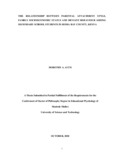THE RELATIONSHIP BETWEENPARENTALATTACHMENTSTYLE, FAMILY SOCIOECONOMIC STATUSAND DEVIANT BEHAVIOURAMONG SECONDARY SCHOOL STUDENTS INHOMABAY COUNTY, KENYA
Abstract
Deviance has devastating effects on the individual and the community as a whole. The purpose of this study was to establish the relationship between parental attachment, family socioeconomic statusand deviant behavior among secondary school students in Homabay County. The study was guided by thefollowing objectives: to assessthe relationship between parental attachment styles and deviant behavior among secondary school students;to evaluatethe relationship between family socioeconomic status and deviant behavior, to determinethemediative role of SES in the relationship betweenparental attachment style anddeviant behavior and;to examinegender differences in deviant behavior among secondary school students. The study adopted attachment theory by John Bowlby and Mary Ainsworthtogether with Structural StrainTheory by Robert Merton. The study employedconvergent research design. The target populationincluded form two students from all the secondary schools in Homabay County, heads of guidance and counseling department, Deputy principals, Principals and selected members of parents’association. Out of the population of 20,160students a representative sample of 512 students wassampledusing stratified random sampling technique. Principals, Deputies, Parents’ association representatives and heads of departmentswere purposively sampled. Instruments for data collection included questionnaires, structured and unstructured interview schedules, focus group discussions and analysis of documents from the sampled schools. Instruments were then piloted. The validity of these instruments was ascertained through expert judgment and piloting while the reliability of the instrumentswas tested using the Split half method and the level of confidence was α ≤ 0.05. Data was analyzed using correlation analysis, t-test analysisand thematic framework. The findings revealed significant negative correlation between parental attachment style and deviant behavior (r=-0.244, p<0.05), significant negative correlation between SES and deviant behavior (r=-0.644, p<0.05), significant positive correlation between SES and parental attachment style (r=.714, p<0.05) and a significant gender difference in deviant behavior among secondary school students in Homabay County. The study concluded that the devianceexhibited among secondary school students in Homabay County is as a result of poverty. The study recommends introduction of free and effective adult education in Homabay County.The findings of the study willbe useful to all the stakeholders.
Collections
- School of Education [45]

